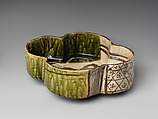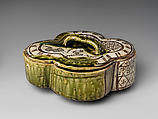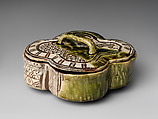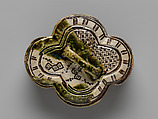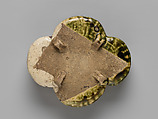Covered Vessel (Futamono) with Plum Tree
Not on view
Invented in Japan in the Momoyama period, Oribe ware introduced vivid patterns and color to a ceramic tradition that had previously favored monochrome vessels. Oribe ceramics were used primarily for serving food and drinking tea, and their stylized, often abstract patterns with brown, black, or brilliant green glazes made them a dramatic addition to the oftentimes subdued dining trays and tearooms. A major technological advance in ceramics—the Motoyashiki multi-chamber climbing kiln, which allowed potters to melt glazes to shiny translucency—made this radically new appearance possible. The vocabulary of designs is encyclopedic, with subjects ranging over the entire field of possibilities: birds and flowers, human figures, landscapes, poetic inscriptions as well as auspicious and popular subjects. The combination of a multitude of sources and images reflects the confidence of the potters to rearrange older iconographies and create new styles. The Oribe type of Mino ware was produced especially to appeal to consumers in Kyoto, primarily to tea afficionados.
The lid of this dish is decorated in a modern-looking, two-tone style, called Green Oribe (Ao-oribe), which features green glaze on parts of the body and designs in iron on the remaining white areas. The bright green sections are complemented by brown iron stripes inspired by textiles, square patterns with tiny dots in their centers referencing shibori tie-dyeing, which was used on Momoyama period tsujigahana fabrics, and stylized motifs of decorative hangings. The ceramic is further enriched by small, impressed chrysanthemum patterns which were pressed into the clay along the rim. In the interior, deep pools of the thick copper green glaze were transformed into glossy, dark surfaces during firing as we can see along the left and bottom corners. In the center, the white clay slip is the ground for a painting of a stylized, flowering plum tree with a bird, most likely a warbler, possibly referencing the “First Song of the Year” (Hatsune) chapter of The Tale of Genji.
Due to rights restrictions, this image cannot be enlarged, viewed at full screen, or downloaded.
This artwork is meant to be viewed from right to left. Scroll left to view more.


